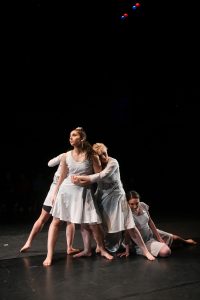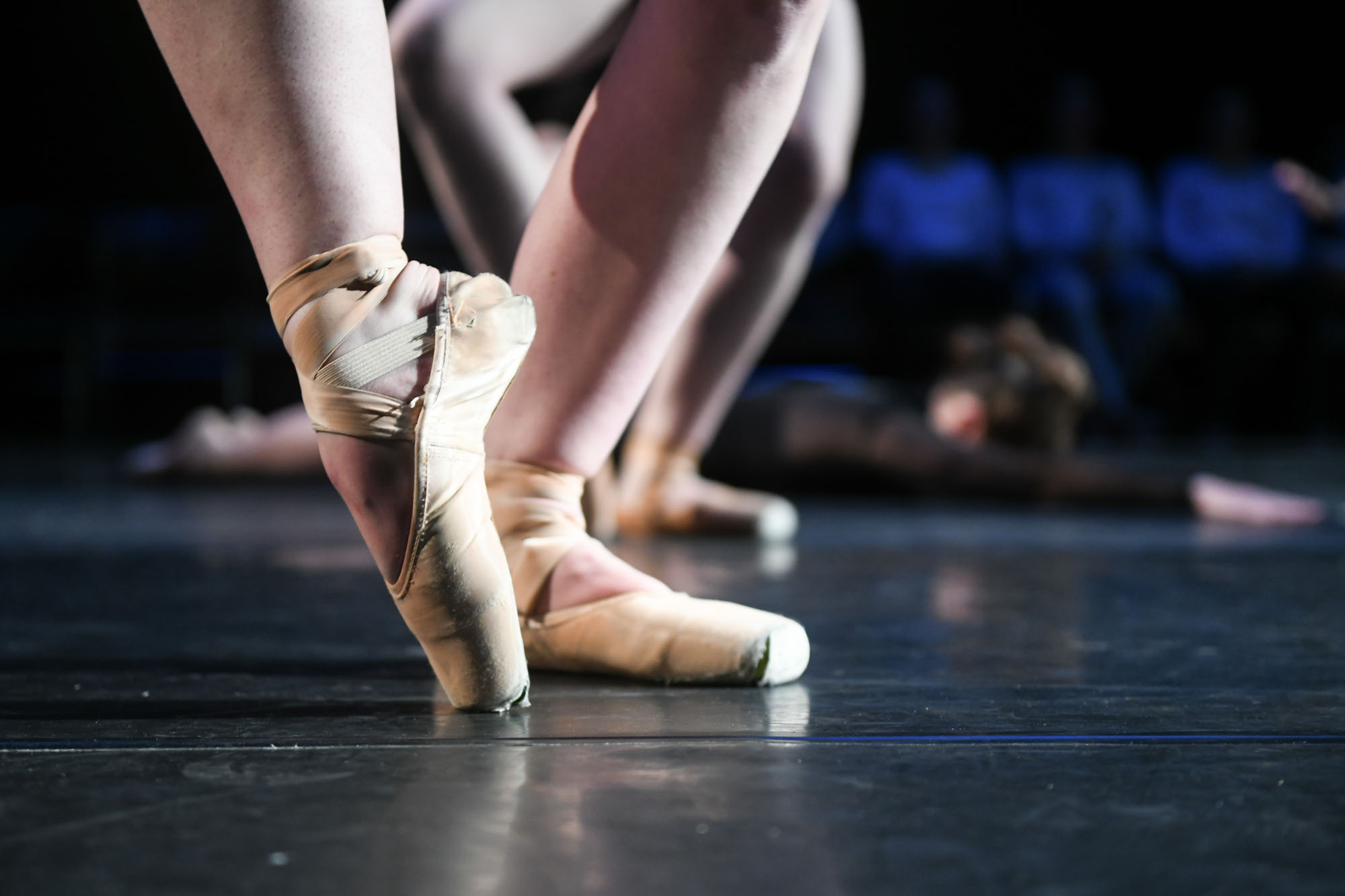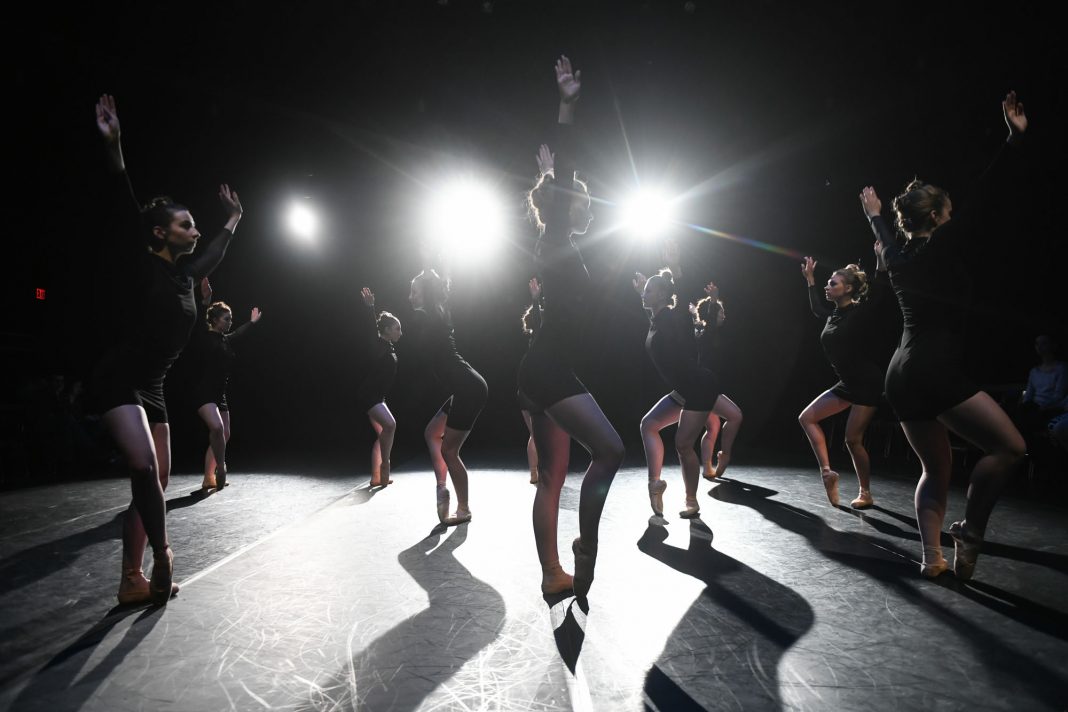As the semester winds down, events pile up – meetings, projects, final concerts and more all desperately fight their way into our schedules, assigning each minute its own urgent task. Still, there are a few shining opportunities left to simply observe and enjoy as something miraculous happens before us, to just be for a while in a world where the rules of existence are rewritten into something entirely new.
One such opportunity was last weekend’s Dance Emerge, a two-act showcase of work from some of the most prized student and faculty choreographers Muhlenberg has to offer. From experimental comedic pieces to a crowd of ballerinas clad in black, Dance Emerge certainly shines a spotlight on the many varied techniques utilized in the dance department. Despite the fact that Dance Emerge comes as the third mainstage dance show of the year, following Moving Stories in the fall and Master Choreographers in the winter, its highly personal setting manages to distinguish this incarnation of Muhlenberg talent from the rest. Dancer Olivia Garcia ’20 notes that Dance Emerge has its own distinct atmosphere.
“The rehearsal process for Dance Emerge is kind of hectic, because it starts as Master Choreographers is beginning its technical rehearsals/show week,” Garcia said. “So, for those involved in that as well, it is definitely a crazy time. Dance Emerge is also different from other shows because there are two fronts to that stage – the audience sits on both sides. So, when creating a work, the choreographer has to remember that and be aware that everyone should have an equally exciting viewing experience, no matter where they are sitting.”

This staging was one of the most striking aspects of the show to me – each of the dancers always had to either be facing somewhat towards the other side of the audience or turned completely one way whilst others faced another. Emily Ancona ’18, one of the show’s five student choreographers, recalls that the demands of the space certainly affected the way she constructed her dance.
“The new way the theater was set up was definitely a challenge,” said Ancona. “There’s something odd about having audience members face each other and having to choreograph [so] both sides can experience the piece.”
Though the strategic positioning of the dancers was transparent for the first few pieces as I got acclimated to the setup of the stage, as the show went on, the tactics choreographers used to ensure that all audience members got an equal view faded into the background as the works themselves asserted their prominence. Still, the show’s opener was one of the standout dances of the entire showcase: an all-important tap piece, Shelley Oliver’s “City Rapids,” began the program with just the boost of energy and impressiveness that the 8:00 p.m. crowd needed.
Despite the fact that it only consisted of three dancers, Emily Berridge ’18, Alison Calamoneri ’18 and Becca Phillips ’18, this work was spellbinding. I could only tear my eyes away from the dancers’ constantly moving yet supremely controlled feet to watch their joyous expressions as they twirled, hopped and ball-changed their way through a rhythm of their own making. Though all three of these women are seniors, I certainly hope that the tap pieces they’ve contributed so much to will not cease to be upon their graduation – and, by the audience’s thunderous applause as the trio took their bows, the theatre and dance community isn’t quite ready to give them up either.
Another highlight of the show was Noah S. Dach’s piece “Tethered,” which made use of two bungee cords in order to help its dancers “fly.” Shantell Cruz ’19 and Nicollette Amico ’18 nearly touched the catwalk of the Black Box as they reached out towards the heavens, approaching each other and the other dancers on stage but never quite making contact. According to Garcia, experiencing the piece as a dancer gave her a unique perspective on its significance and meaning.

“The work was really dynamic, exciting and multilayered,” Garcia said. “The concept of the work was about fallen angels, but more than that, to me, it was about falling, releasing and then catching yourself again. There were many huge and explosive moments in the work that required huge spurts of energy, and we as dancers had to continue to power through them as if constantly being chased. I felt as though the work made people feel like they were on the edge of their seats, and to me, that creates excitement and has the audience invested in the work, which is always really rewarding.”
“Tethered” certainly provided its viewers with an intriguing narrative: though at first it seemed as though the two flying dancers were almost superhuman, soaring higher and skimming lower than any of the others might dare, it was later clear that they were bound to their cords, tethered to one place. While the surrounding dancers lifted each other effortlessly to heights almost as ambitious as those reached by the flyers, the flyers themselves could not seem to connect to anyone – not even the invisible force they reached out to as they floated towards the ceiling.
On a more optimistic note, Ancona’s piece “Gardenia” was an absolute delight to behold. Featuring five dancers dressed in various shades of bright yellow, orange and red, the work was a slice of sunshine. Each dancer was like a flower child, their hair braided and loose as they intertwined with the others in sweet movements of bliss.
“This piece was inspired sort of by being a senior this year and trying to appreciate the people around me,” said Ancona. “I wanted the piece to be very intimate and warm, so I found a lot of inspiration for choreography through my cast, having them assist in choreography too.”
This piece reminded me why dance shows are so integral to the diversity and roundedness of the arts at Muhlenberg: with only a few notes, some well-designed costumes and the vision and talent of choreographers and dancers alike, a single work can completely change one’s mood, can alter how they go about the rest of their day. Dance has the power to change us by reflecting back what the human form can do. Dance lets us know what we’re capable of. Dance reminds us that within every move we make, there’s a story – a story that might like to be told.
Brooke is a senior double majoring in English and Media & Communication. She's passionate about french toast, Kate Bishop, Steven Universe and the ocean coasts of Ireland. On campus, she is a Writing Tutor, Orientation Leader and member of the Girls Next Door, Muhlenberg's all-lady a capella group. She could not be more excited to serve as your Editor-In-Chief this year!






















